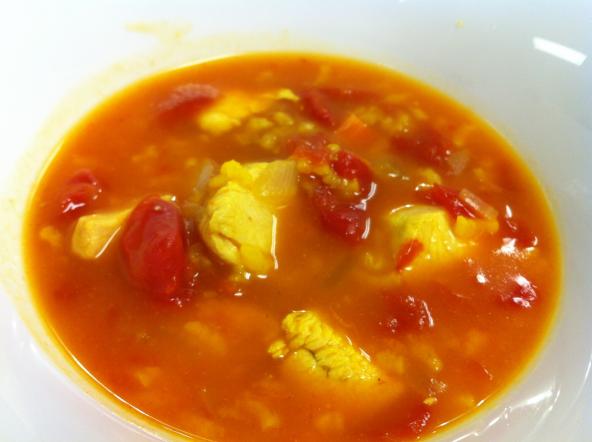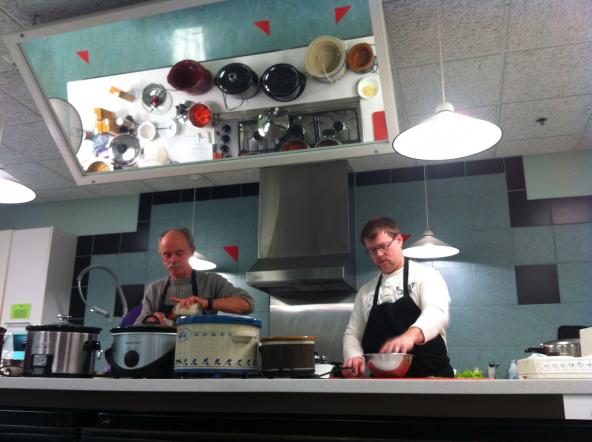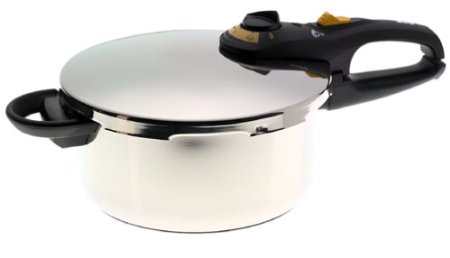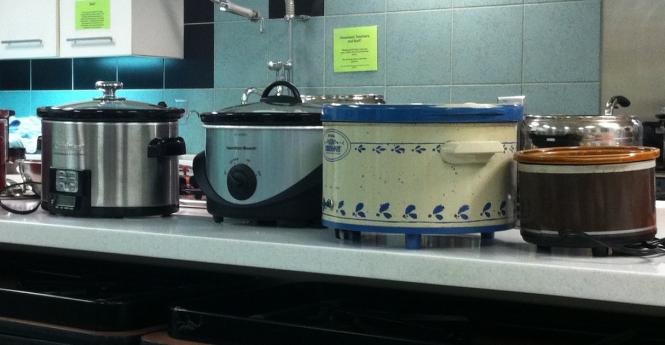I’d been using a slow cooker for several months before taking Jeff Woodworth's Slow Cooker & Pressure Cooker class at the Wedge Co-op this winter. Life for me as a part-time student is hectic and heavily scheduled and finding time to cook often takes a backseat to studying, work, social life, and a myriad of extracurricular activities. Encouraged by the prospect of producing lots of food with minimal effort, I decided to invest more time in learning these do-ahead techniques.
Jeff’s kitchen was hopping as soon as I stepped into the small classroom at the Wedge. Every seat was taken, and there were three prep cooks in the kitchen with Jeff, all busily preparing ingredients and monitoring steaming pressure cookers. Each student’s place was set with a cup of water and utensils. In the next two hours, Jeff and his team would create four dishes using slow cookers, pressure cookers, and sometimes a combination of the two.
Slow Cookers
As soon as I started using a Crock Pot – about a month before Jeff’s class at the Wedge – I was hooked. My roommates joked that there was a rotating Crock Pot Special in the house as I experimented with recipes I found online. It turns out that you can really do a lot with a slow cooker, including bake bread (which I haven't tried yet, but is next on my list). It was really simple to chop up a bunch of vegetables, plop them in the slow cooker, crank it on, and come home later to a steaming pile of healthy food when I was starving from a long day of work and school. Not only did slow cooking allow me to experiment and adapt new recipes that required longer cooking times, it produced food in large enough quantities to share with my roommates AND to store leftovers for subsequent lunches and dinners. Since this new revelation, I've been trying to devise ways to build slow cooking into my daily routine to ensure I always have something hot and ready for dinner, and to pack for lunch the next day.
 A slow cooker soupRight away during Jeff's
class, I learned several amateur mistakes I’d been making with my slow cooker.
The first thing Jeff cautioned us about was overcooking chicken, which, it
turned out, I had done just the night before while making a batch of chicken
soup. Chicken, Jeff told us, would overcook if left in a slow cooker, as the
sustained temperature inside the cooker is too high to produce a tender effect.
To use chicken in a slow-cooked dish, your best bet is to wait until the meal
is about to be served, cook the chicken separately, and add it to the slow
cooker just before serving. Ok, a few more steps than I was hoping for, but
after suffering through last night's chicken-jerky, I decided it was well worth
it.
A slow cooker soupRight away during Jeff's
class, I learned several amateur mistakes I’d been making with my slow cooker.
The first thing Jeff cautioned us about was overcooking chicken, which, it
turned out, I had done just the night before while making a batch of chicken
soup. Chicken, Jeff told us, would overcook if left in a slow cooker, as the
sustained temperature inside the cooker is too high to produce a tender effect.
To use chicken in a slow-cooked dish, your best bet is to wait until the meal
is about to be served, cook the chicken separately, and add it to the slow
cooker just before serving. Ok, a few more steps than I was hoping for, but
after suffering through last night's chicken-jerky, I decided it was well worth
it.
Jeff also advised students to sauté vegetables before putting them in the slow cooker to help release flavor during cooking. I had been resistant to the idea, as I’d wanted to keep slow cooking as low maintenance as possible; to be honest, when I'm in a rush, I still skip this step to keep the amount of stuff I need to wash to a minimum, and I try to compensate by adding more fresh herbs and spices after the food is done cooking. But it is true that the overall flavor of dishes does remain a little flat if the vegetables are not sautéed beforehand.
In the class, I also picked up some tips about the general idea behind the slow cooker and what to look for when purchasing a slow cooker. Slow cookers work on the principle of slowly simmering food at low temperatures for long periods of time. It's almost impossible to burn food in a slow cooker, which makes it perfect for creating flavorful stews without having to constantly be vigilant of an operating stovetop. Most slow cookers also have a ceramic interior, which means you never have to worry about the bottom of your food getting burned. The slow cooker maintains an even and low temperature through cooking, though there are some big drawbacks to using a slow cooker. First, though the long cooking time makes it great for leaving at home and letting it cook all day so you can come home to a warm, fragrant meal, the long cooking time can zap the flavor out of vegetables, and make foods “soggy” if they become over-cooked. Meats are also difficult to cook to a perfect texture, and Jeff encouraged us to cook and add meat separately to dishes that we slow cooked to preserve flavor and texture. Users should also be careful not to take the top off of the cooker while it's simmering, as more nutrients are likely to escape this way. Taking the lid off also causes the crock to lose a tremendous amount of heat, slowing the amount of time it will take for the food to get to and maintain simmering temperature.
Similar to a pressure cooker, you should purchase a slow cooker based on how many people you're feeding, what your intended use is, and any extra features you think might come in handy. For slow cookers, the more control options you have, the better. Some slow cookers allow you to pre-set cooking start and end times to ensure your food is not over-cooked. These have a “warm” mode that will keep your food warm, but not continue to cook it, preventing flavor loss. There are also styles that have more than the standard two or three heat settings (low, medium, and high), which gives you much more control of the cooking environment. If you plan to use your slow cooker a lot, I'd recommend spending the extra money for one of the programmable cookers. In terms of shape, oval slow cookers are great if you want to cook a whole chicken.
 Slow Cooker & Pressure Cooker class at the Wedge Co-op
Slow Cooker & Pressure Cooker class at the Wedge Co-op
Pressure Cookers
Though I did glean some great tips from Jeff about slow cooking, I was most excited for the pressure cooker portion of the class. I’d learned to cook from my mother, who cautioned me against using a pressure cooker, citing first-hand accounts of explosive episodes in her mother’s kitchen. After reading more about it, I found that modern pressure cookers have lots of new safety features to make sure your kitchen stays explosion free. I decided to wait for Jeff’s class before I purchased one, and I’m glad I did, because he gave some great advice about what to look for.
Pressure cookers work, basically, by raising the boiling point of water. They create a closed environment that forces steam through foods to transfer heat. When the cooker is sealed and set over high heat, steam pressure builds from 5 to 15 psi, depending on what kind of pressure cooker you have, and the internal temperature rises considerably higher than water's normal boiling point. This enables cooking at high temperatures without destroying the food because of the even distribution of pressure throughout the system. The high pressure also allows the fiber in the food to tenderize and flavors to disperse through the system in much less time than regular boiling methods.
Safety, of course, is a key feature in a pressure cooker, and worth a little extra money. Most old-fashioned pressure cookers don’t have safety mechanisms to ensure that the cooker can only be opened when the pressure has been brought down to a safe level. Jeff showcased several brands of cookers, discussed their safety mechanisms, and gladly answered questions about people’s personal pressure cookers, which some had brought into class.
My question before coming to class was whether or not a pressure cooker could double as a pressure canner. I’d read through copious reviews of the 10 quart Fagor Duo pressure cooker, and users vacillated wildly between whether or not pressure cookers should double as canners, though it was marketed as such. Jeff's opinion was yes, they can be used for both, though the limiting factor is the size of the base of the pressure cooker. Many have a narrower base to hasten cooking time; canners need a wider base to accommodate more jars. Jeff also mentioned a couple of times that “some tools will do things others won’t,” in regards to purchasing specialized equipment for the kitchen. His point was, if you want a great pressure cooker, and a great canner, then get one of each, but don't expect to be able to do a lot of canning with a pressure cooker.
 Fagor Duo Pressure CookerYou should purchase a
pressure cooker depending on what you intend to use it for, how many people you
intend to feed, and its safety features. I decided to go with the Fagor
Duo 4 quart model instead of the much larger 10 quart version I was
contemplating for canning purposes. I figured the size and scale of the 4 quart
was much better suited to my actual cooking needs, and the 10 quart would be
much too large to be used practically for cooking much smaller portions. Using
it definitely took some getting used to, and I was still nervous the first few
times, but I'm glad that I got the confidence to start using it during Jeff's
class, or I might never have tried it.
Fagor Duo Pressure CookerYou should purchase a
pressure cooker depending on what you intend to use it for, how many people you
intend to feed, and its safety features. I decided to go with the Fagor
Duo 4 quart model instead of the much larger 10 quart version I was
contemplating for canning purposes. I figured the size and scale of the 4 quart
was much better suited to my actual cooking needs, and the 10 quart would be
much too large to be used practically for cooking much smaller portions. Using
it definitely took some getting used to, and I was still nervous the first few
times, but I'm glad that I got the confidence to start using it during Jeff's
class, or I might never have tried it.
Nutrient Preservation
Another point of discussion that we kept circling around to during class was the ability of slow cookers and pressure cookers to better preserve nutrients than regular stove-top cooking, which was not something I'd even considered to be a benefit of using a slow or pressure cooker. I'd assumed that the high heat of a pressure cooker, and the length of cooking time in a slow cooker, would actually zap more nutrients from dishes, but it turns out pressure cooking and slow cooking can help retain more nutrients than other cooking methods – if you also consume the excess water. Water soluble vitamins like C and E are most vulnerable to being destroyed during the cooking process, but it turns out that these nutrients can hang out in the condensation and water by-products of a slow cooker and pressure cooker, making it possible to retain these nutrients if the water is re-used quickly. I've read lots of different and conflicting claims about the actual efficiency of pressure cooking versus regular stove-top cooking, and in reality it probably also depends heavily on how fresh your veggies are, how they've been stored, and how far they traveled before reaching your kitchen just as much as the preparation method.
Tips and Tricks
Jeff's class gave me a lot more ideas for types of foods to try out in slow and pressure cookers – not just my go-to vegetable stews or curries. One great tip was using cashews as a thickener when making soup in a pressure cooker, since it can pulverize the cashews with the incredible amount of pressure it uses. I was surprised by how many different textures and styles of food that could be made using these tools, and walked away with the recipes for the dishes Jeff made in class, excited to try them out at home.
If you've got a pressure or slow cooker at home and are looking for more ideas, I would definitely recommend taking a class to build your confidence and repertoire. Having a slow cooker and pressure cooker in your arsenal of kitchen appliances definitely increases the ease and convenience of making healthy, home-cooked food, and saves a ton of time. I've made a habit of using each one multiple times a week this winter to make warm, hearty, healthy dishes with fresh ingredients all winter long.
The Wedge will be offering Jeff Woodworth’s class, The Slow Cooker and Pressure Cooker, again on Tuesday, March 26th ,from 7 – 9 p.m. The class costs $49 for members/$59 for non-members.
Note: The Wedge Co-op is a sponsor of Simple, Good, and Tasty and gave the writer admission to the class for review.

Anna Cioffi is an organizer with the Land Stewardship Project, and studies nursing. Her last article for us was Urban Agriculture Minneapolis Needs Your Voice.

